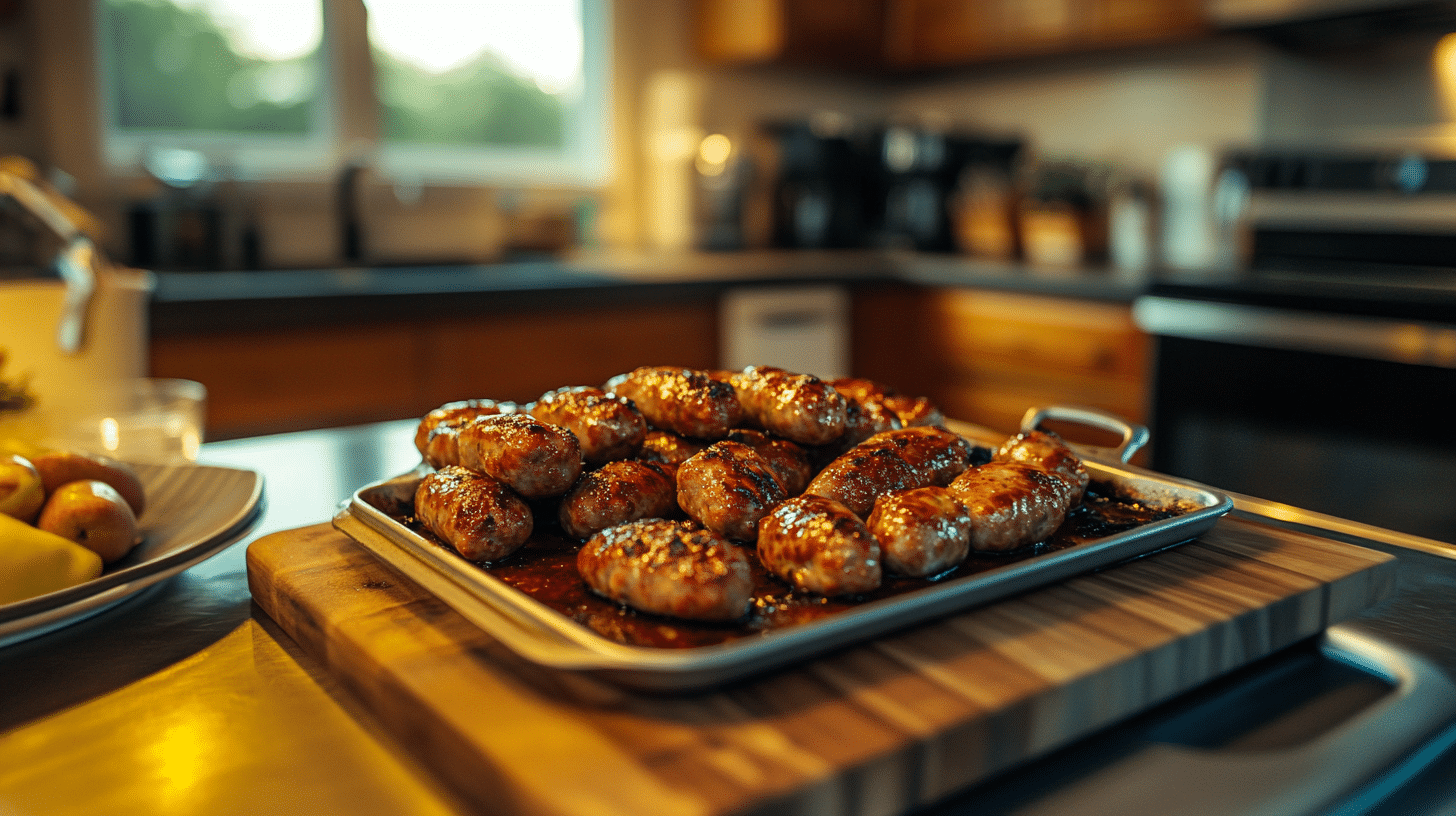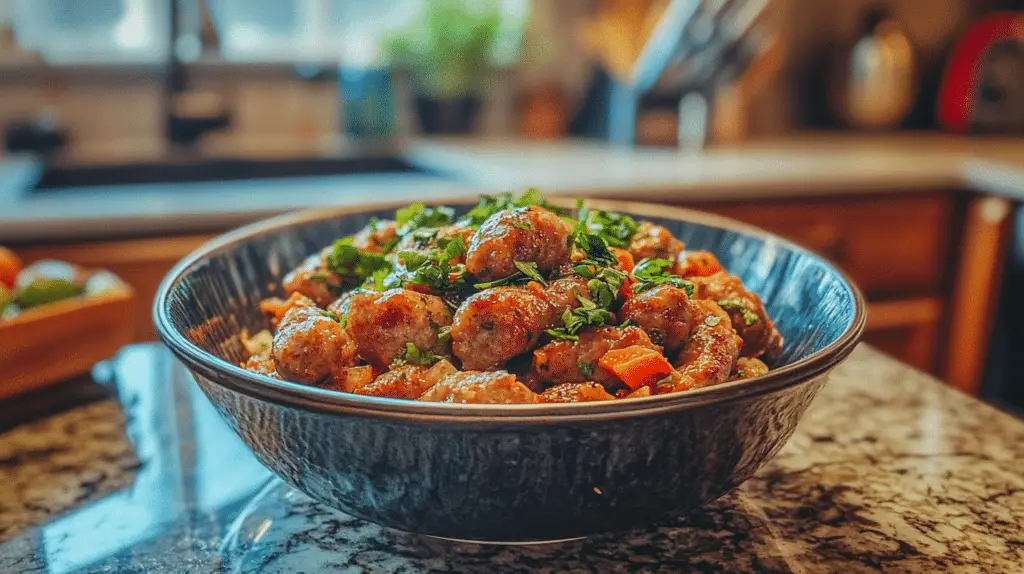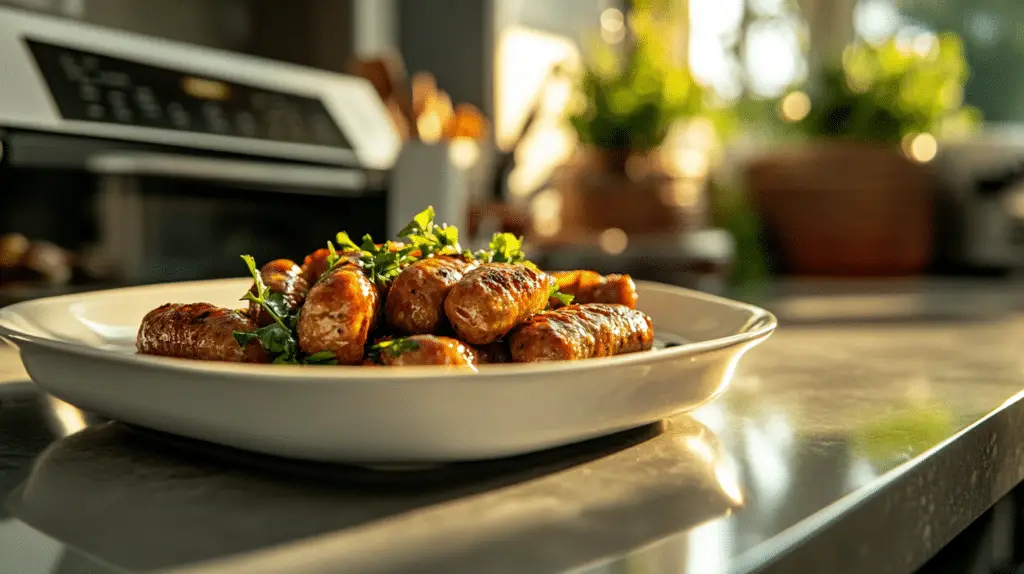What Makes Breakfast Sausage Links a Breakfast Favorite?
Few breakfast items rival the versatility and flavor of breakfast sausage links. Their bold, savory taste and quick cooking time make them a staple in American households. Whether paired with eggs or pancakes or incorporated into a variety of recipes, these sausages are an easy way to elevate your morning meal.
For an even more indulgent breakfast experience, serve sausage links with this Easy Crockpot Breakfast Casserole. The combination of creamy eggs and sausage offers a hearty, crowd-pleasing option.
Table of Contents
Exploring the Types of Breakfast Sausage Links
Breakfast sausage links come in various types, ensuring there’s an option for everyone, regardless of dietary preference.
1. Classic Pork Sausage
- Flavor Profile: Rich, juicy, and seasoned with herbs like sage, marjoram, and black pepper.
- Perfect For: Traditional breakfasts with eggs and hash browns.
2. Chicken and Turkey Sausage
- Flavor Profile: Leaner than pork with a lighter, slightly milder taste.
- Perfect For: Health-conscious eaters or those seeking lower-fat alternatives.
3. Plant-Based Sausage Links
- Flavor Profile: Crafted from soy, lentils, or pea protein, often mimicking the taste of traditional sausages.
- Perfect For: Vegetarians, vegans, or those reducing meat consumption.
To add variety to your breakfast table, try pairing sausage links with Healthy Banana Blueberry Muffins. The sweet muffins balance the savory notes of the sausage for a well-rounded meal.
The Ingredients Behind Great Breakfast Sausage Links
The secret to flavorful sausage links lies in their ingredients. Whether you buy them pre-made or make your own, understanding the components can help you appreciate their savory appeal.
Essential Ingredients
- Meat:
- Traditional sausages use ground pork.
- Alternatives include chicken, turkey, or plant-based proteins.
- Fat: Provides moisture and flavor. A 25% fat ratio is ideal for juicy sausage.
- Seasonings:
- Traditional: Sage, black pepper, marjoram, fennel.
- Spicy: Red pepper flakes or cayenne.
- Sweet: Maple syrup, brown sugar, or honey.

5 Best Ways to Cook Breakfast Sausage Links to Perfection
Ingredients
Method
- In a large bowl, mix ground meat with all seasonings and optional sweetener or spice until well combined.
- If using casings, rinse and soak them in warm water for 30 minutes.
- Attach casing to sausage stuffer and slowly fill with the meat mixture, leaving room to twist into links.
- Twist the filled sausage every 3–4 inches to form links. Alternate twisting directions for each link.
- Cut links apart with scissors if needed.
- To cook, pan-fry over medium heat for 8–10 minutes, turning occasionally, or bake at 375°F for 20 minutes, flipping halfway.
- Refrigerate raw links for up to 3 days or freeze for up to 3 months.
Nutrition
Notes
Tried this recipe?
Let us know how it was!
Homemade vs. Store-Bought Sausage Links
When it comes to breakfast sausage links, you can choose between homemade and store-bought options:
- Homemade:
- Pros: Full control over ingredients and seasoning. Customizable for dietary needs.
- Cons: Requires time and tools like a sausage stuffer and casings.
- Store-Bought:
- Pros: Convenient, with plenty of variety (from traditional to plant-based).
- Cons: This may include preservatives or higher sodium levels.
For a creative twist, consider incorporating sausage links into a Savory Sausage Quiche. This rich and hearty dish is perfect for weekend brunches or special occasions.
How to Make Homemade Breakfast Sausage Links
Crafting your sausage links at home can be rewarding, allowing you to customize flavors and ensure high-quality ingredients.
Step-by-Step Guide to Making Breakfast Sausage Links
Making your breakfast sausage links at home is not only rewarding but also allows you to customize flavors and control ingredients. Here’s an expanded step-by-step guide to ensure your homemade sausage links turn out perfect every time.
1. Prepare the Meat
The foundation of great sausage links starts with the right meat-to-fat ratio.
- Meat Selection: Use a blend that’s 75% lean meat to 25% fat for a juicy and flavorful result. Pork shoulder is an excellent choice for pork sausages, but you can also use chicken thighs, turkey, or beef for variations.
- Why the Ratio Matters: Too little fat can result in dry sausages, while too much fat can make them greasy. Striking the right balance ensures moisture and flavor.
- Pro Tip: If you’re using leaner meats like turkey or chicken, consider adding a small amount of extra fat, such as olive oil or ground pork fat, to maintain texture.
2. Season the Meat
The seasoning blend is what sets breakfast sausages apart from other types.
- Basic Seasoning: Combine sage, fennel seeds, salt, and freshly ground black pepper for a classic flavor.
- Add Extra Flair:
- For a sweet twist, mix in a tablespoon of maple syrup or brown sugar.
- For a spicy kick, include red pepper flakes or cayenne pepper.
- For herbal notes, add marjoram or thyme.
- Mixing: Place the ground meat in a large bowl and sprinkle the seasoning evenly over it. Use your hands to gently but thoroughly mix the meat and spices until well combined.
3. Soak and Prepare the Sausage Casings
Casings hold the sausage mixture together and give it that traditional link shape.
- Natural Casings: Use hog or sheep casings for a natural, snappy bite. These can be found at butcher shops or online.
- How to Soften Casings:
- Rinse the casings under cold water to remove excess salt (they’re usually packed in salt for preservation).
- Soak them in warm water for 30 minutes to make them pliable and easy to work with.
- Check for holes by running water through the casing and discard any damaged sections.
- Pro Tip: If you’re new to using casings, buy extra to practice stuffing and twisting.
4. Stuff the Sausage Casings
Stuffing the casings requires some technique but becomes easier with practice.
- Tools You’ll Need: A sausage stuffer or a meat grinder with a stuffing attachment.
- Steps:
- Fit the sausage stuffer nozzle with a pre-soaked casing, leaving a 3-inch tail at the end.
- Carefully fill the casing with the seasoned meat mixture, using even pressure to avoid air pockets.
- Stop before the casing is too tight to allow room for twisting into links.
- Pro Tip: If you don’t have casings, you can skip this step and shape the mixture into patties instead.
5. Twist and Cut Links
Once the casings are filled, it’s time to create individual sausage links.
- Twisting Technique: Pinch the casing every 3–4 inches and twist several times to form a link. Alternate the direction of twisting for each link to keep the shape secure.
- Cutting Links: Use kitchen scissors to cut the links apart if you prefer individual sausages. Otherwise, leave them connected for easier storage.
- Pro Tip: Handle gently to prevent the casings from bursting, especially when twisting.
6. Store or Cook Immediately
- To Cook: Fresh sausages can be pan-fried, baked, grilled, or air-fried immediately after preparation.
- To Store:
- Place uncooked links in an airtight container or vacuum-sealed bag.
- Refrigerate for up to 3 days or freeze for up to 3 months.
- Label the package with the date and type of sausage for easy identification.
- Pro Tip: Freeze links individually on a baking sheet before transferring them to a container to prevent sticking.
How to Cook, Serve, and Enjoy Breakfast Sausage Links
Cooking Methods for Breakfast Sausage Links
The cooking method you choose for breakfast sausage links can enhance their flavor and texture. Each method has its unique advantages, so whether you prefer crispiness, juiciness, or convenience, there’s an option to suit your taste.
1. Pan-Frying
This classic method delivers perfectly crispy exteriors and juicy interiors.
- Steps:
- Preheat a nonstick skillet over medium heat and add a small amount of butter or oil.
- Place the sausage links in the skillet, ensuring they don’t touch.
- Cook for 8–10 minutes, turning them frequently for even browning.
- Pro Tip: Add a splash of water to the pan during the last few minutes to help them cook through without burning.
2. Oven-Baking
Oven-baking is ideal for cooking large batches and requires minimal effort.
- Steps:
- Preheat your oven to 375°F.
- Line a baking sheet with parchment paper or foil and arrange the sausage links with space between them.
- Bake for 20 minutes, flipping halfway through.
- Pro Tip: Use a wire rack on the baking sheet to let the fat drip away, creating a leaner sausage.
3. Grilling
Grilling adds a smoky flavor and a charred exterior, perfect for summer breakfasts.
- Steps:
- Preheat the grill to medium heat and lightly oil the grates.
- Place the sausages directly on the grill.
- Cook for 10–12 minutes, turning occasionally to ensure even cooking.
- Pro Tip: Use indirect heat to prevent the casings from bursting.
4. Air Frying
Air frying is a quick and healthy option, producing evenly cooked sausages with a crispy finish.
- Steps:
- Preheat the air fryer to 375°F.
- Arrange the sausage links in a single layer in the basket.
- Cook for 8–10 minutes, shaking the basket halfway through.
Creative Serving Ideas for Breakfast Sausage Links
Sausage links are versatile and pair beautifully with a variety of dishes. Here are some ideas to make your breakfast or brunch memorable:
1. Classic Breakfast Pairings
- Eggs and Hash Browns: Scrambled or fried eggs with crispy hash browns are timeless companions for sausage links.
- Pancakes or Waffles: The sweet and savory combination of maple syrup and sausage is irresistible.
- Ranch Roasted Potatoes: Their crispy texture complements the juicy sausage links perfectly.
2. Incorporate Into Recipes
- Breakfast Burritos: Combine sausage links with scrambled eggs, cheese, and salsa in a tortilla.
- Sausage-Stuffed Biscuits: Wrap cooked sausage links in biscuit dough and bake for a grab-and-go breakfast.
- Breakfast Pizza: Cooked sausage links can be topped with eggs, cheese, and vegetables on a pizza crust.
3. Brunch-Worthy Dishes
- Sausage and Veggie Skewers: Alternate sausage links with bell peppers, zucchini, and cherry tomatoes for a colorful presentation.
- French Toast Sandwiches with Sausage: Layer sausage links between slices of French toast for a savory-sweet treat.
- Savory Sausage Quiche: Incorporate sausage into a creamy quiche for a sophisticated brunch dish.

FAQs About Breakfast Sausage Links
1. What’s the ideal meat-to-fat ratio for making sausages?
A ratio of 75% lean meat to 25% fat ensures juiciness and flavor.
2. Can sausage links be frozen?
Yes! Both cooked and uncooked sausage links can be frozen.
- Storage Tips: Use airtight containers or vacuum-sealed bags.
- Shelf Life: Uncooked sausages last up to 3 months in the freezer, while cooked ones last about 2 months.
3. Are there gluten-free sausage options?
Absolutely! Many store-bought brands offer gluten-free sausages. Homemade sausages can also be made gluten-free by using appropriate seasonings and avoiding fillers.
4. How can I make sausages healthier?
- Use leaner meats like turkey or chicken.
- Season with fresh herbs instead of salt.
- Bake or air fry instead of pan-frying.
5. What are the best condiments for sausage links?
- Sweet: Maple syrup or honey.
- Savory: Mustard, hot sauce, or ketchup.
- Creamy: Hollandaise sauce or sour cream for a decadent touch.
Breakfast Sausage Links: Final Thoughts
Why Breakfast Sausage Links Are a Must-Have
Breakfast sausage links are more than just a staple—they’re a versatile, flavorful addition to any morning meal. From their savory taste to their adaptability in countless recipes, these little sausages are the perfect way to elevate your breakfast or brunch. Whether you’re enjoying them alongside eggs and toast, incorporating them into a hearty quiche, or experimenting with creative recipes, sausage links bring bold flavors and satisfying textures to the table.
Versatility and Customization
One of the best things about breakfast sausage links is their ability to adapt to different dietary preferences and meal ideas.
- For Meat Lovers: Classic pork sausage links are a timeless choice.
- For Health-Conscious Eaters: Turkey, chicken, or plant-based sausage links offer leaner or meat-free alternatives.
- For Creative Cooks: Sausage links can be used in breakfast burritos, pizzas, casseroles, and more, making them a key ingredient in diverse recipes.
Pair them with complementary dishes like Healthy Banana Blueberry Muffins or Ranch Roasted Potatoes to create a complete and satisfying meal.
Cooking Made Easy
Whether you’re pan-frying, grilling, baking, or air frying, breakfast sausage links are quick and simple to prepare. Their convenience makes them perfect for busy mornings or leisurely weekend brunches. With a little planning, you can cook a batch in advance and freeze them for ready-to-eat breakfasts throughout the week.
Healthier Options Without Sacrificing Flavor
If you’re looking to enjoy sausage links with a healthier twist, there are plenty of ways to do so:
- Opt for lean meats or plant-based alternatives.
- Bake or air fry instead of pan-frying to reduce oil.
- Use fresh herbs and spices instead of sodium-heavy seasonings.
A Dish for Every Occasion
From weekday breakfasts to festive brunch gatherings, breakfast sausage links fit seamlessly into any occasion. They’re not just limited to mornings either—try adding them to lunch or dinner recipes for an extra dose of protein and flavor.
For example, incorporating them into a Savory Sausage Quiche can turn your breakfast staple into a sophisticated meal that’s perfect for entertaining.
Ready to Elevate Your Breakfast?
It’s time to make breakfast sausage links the highlight of your morning meals. With endless preparation methods, pairing options, and recipes to try, these savory sausages are sure to become a household favorite. So, grab your ingredients, choose your cooking method, and get ready to enjoy the irresistible flavor of breakfast sausage links.
Happy cooking and enjoy every bite!
📌 Follow us on Pinterest and 👍 Like us on Facebook to stay inspired!
